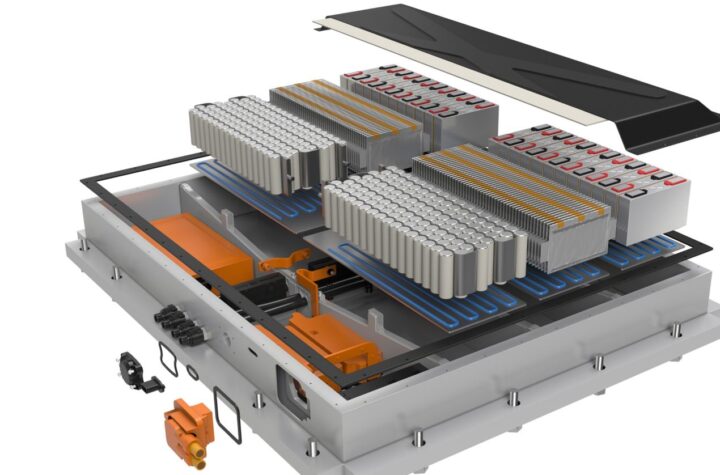
Nissan Titan
 |
Titan’s interior is car-like and simple. The center stack houses the radio, CD player and large controls for the HVAC. The metallic surfaces are from design cues picked up from the Nissan family. |
 |
A unique two-stage hinge allows the King Cab’s rear door to open 186 degrees, almost perpendicular to the body. The Crew Cab doors open like a sedan. |
 |
| If storage is at the top of the list, Nissan offers a storage area mounted in the rear side-panel of the bed. |
 |
| There are no hydroformed parts on the Nissan/Tower Automotive-designed frame. Shortened versions of this platform will show up under the next Frontier and Xterra. |
 |
The F-150’s frame borrows its front section from the Excursion and features cast-aluminum lower control arms. The chassis stretches the new truck’s wheelbase by six inches. Ford claims that the frame is nine times stiffer in torsion and 50 percent stiffer in bending than the outgoing frame. |
Dominique insists that the evocative name GM abandoned was the perfect one-word summation of Nissan’s intentions to step into the large pickup arena in a forceful, effective manner.
“To earn credibility in a full-sized pickup truck, you need real truck horsepower and real truck torque,” asserts Dominique. “We gave our Japanese colleagues performance targets and asked them to meet those objectives at the lowest possible cost.”
One of those objectives — a 9,400-pound towing capacity — was especially ambitious. Fortunately, Nissan had a V-8 engine and 5- speed automatic in production for Infiniti Q45 and M45 luxury sedans to serve as a suitable starting point.
The initial plan was to convert the block material from aluminum (with cast-iron cylinder liners) to iron as a cost-savings measure. That idea was scrapped when weight and fuel economy became an issue, so the final VK56DE V-8 keeps the lightalloy block and head from the parent Infiniti VK45DE design.
In the interests of durability, the forgedsteel crankshaft supported by cross-bolted main bearings also made the leap. Two features that did not were the exotic titanium valves used to sustain the vehicle’s 6,700- rpm redlines and variable valve timing.
To meet torque and power requirements, Nissan engineers stretched bore and stroke dimensions to their practical limits. Boosting the bore from 93 to 98 mm and stroke from 82.7 to 92 mm bumped piston displacement from 4.5 to a more meaty 5.6 liters.
Topping the reconfigured V-8 is an ultralong- runner composite-plastic intake manifold, the second measure aimed at plumping up the torque curve at the low end where pickup truck owners live and work.
Lowering the compression ratio from 10.5 to 9.8:1 dropped the fuel requirement from premium to regular unleaded.
Nissan hesitates to expose its hand at Automotive Industries July 2003 25 this stage of the game (Titan doesn’t arrive in dealer showrooms until December), so output is currently rated “over” 300 horsepower at 4,900 rpm and “375-plus” lb-ft of torque at 3,200 rpm. For reference, the Infiniti V-8 produces 340 horsepower at 6,400 rpm and 333 lbs.-ft. of torque at 4,000 rpm. Dominique adds that 90 percent of peak torque is available from 2,500 rpm to give Titan excellent off-road towing, hauling and driving capabilities.
Now that Hemi, Vortec and Triton are part of the modern pickup-truck family’s vocabulary, the new Titan engine had to have a handle as well. The “Endurance V-8” name that was chosen doesn’t have much ring but Dominique is holding some of his options — such as variable valve timing — in reserve for the future. A dedicated line built as part of a $500-million expansion of Nissan’s Decherd, Tenn., facility manufactures this powerhouse.
At launch, the Titan’s 5.6L V-8 powers the whole show. It’s teamed with the first 5- speed automatic transmission in the lightduty pickup truck class. Also borrowed from the Infiniti Q45 and M45, what Nissan calls its IK transmission has been reinforced inside and out for this tougher assignment.
Three out of the five gear ratios were altered to meet Dominique’s ambitious throttle response, acceleration, towing, gas mileage and highway cruising performance targets.
Following GM’s lead, a tow-haul mode is provided. Dominique believes demand for a manual transmission isn’t great enough to warrant the necessary engineering resources. Adding a V-6 is, however, part of the near-future game plan.
The stage on which Titan’s powertrain will show its stuff is a highly conventional 139.8- inch-wheelbase ladder frame. Developed in Japan by Nissan chassis engineers teamed with frame-supplier Tower Automotive representatives, the design is fully boxed from stem to stern but it eschews the hydroforming that is quickly becoming a favored feature among the domestics.
The unequal-length control arm front suspension is an all-steel design with coil-overdamper units and an anti-roll bar. The powerassisted rack-and-pinion steering gear is rubber isolated at all three of its mounting points. Shackles for the dual-rate semi-elliptic rear springs which support the Dana 44 axle are mounted outboard of the rails to minimize what Dominique terms “low-hanging fruit” (projections that could snag a rock while offroading).
 Dana also contributes the framemounted front differential and half-shafts for Titans equipped with optional four-wheel drive. The high/low-range transfer case is manufactured in house in two variations. One is a conventional part-time design, the other engages drive to the front axle on demand. Each is controlled by a dash-mounted mode switch. Titan’s drive shaft is a single- piece, very large diameter aluminum-tube component.
Dana also contributes the framemounted front differential and half-shafts for Titans equipped with optional four-wheel drive. The high/low-range transfer case is manufactured in house in two variations. One is a conventional part-time design, the other engages drive to the front axle on demand. Each is controlled by a dash-mounted mode switch. Titan’s drive shaft is a single- piece, very large diameter aluminum-tube component.Four-wheel disc brakes with Bosch ABS are standard. Four-wheel drive Titans have a standard brake-application traction control system and Nissan’s VDC yaw stability system as optional equipment.
Three wheel and tire packages are offered. The standard fare is 7.5×17-inch painted steel wheels skinned with 245/75R-17 radials. Aluminum-alloy 8.0×18-inch rims matched to 265/70R-18 tires are optional. An off-road package includes 7.5×17-inch brushed-aluminum wheels, B.F. Goodrich All-Terrain T/A 285/70R-17 tires, Rancho shock absorbers, a lower final-drive ratio, a locking rear differential, fog lamps and protective skid plates.
Two Titan cab and bed combinations will lead the way at product launch: what Nissan calls a King cab with a 6.5-foot bed and a crew cab with a 5.6-foot bed. Both share a 139.8-inch wheelbase. According to Dominique, the crew cab’s 127 cubic foot interior volume beats every other half-ton crew cab on the market, including Ford’s 2004 F-150. The King’s claim to fame is special two-stage hinges that permit the halfsized suicide-style rear doors to open past their regular 85-degree checks to stop nearly flush with the truck’s flanks. The idea is to ease access in tight confines when oppositehinged doors can trap occupants.
As is the norm in contemporary pickup trucks, Titan interior decor is at least car-like if not lavish. Bench and bucket-with-console front configurations are offered and leather trim is standard on the top of three available trim levels. Half a dozen air bags are available: in addition to dual-stage bags for frontal-impact protection of the driver and front-seat passenger, there are seat-mounted side air bags and curtain-type bags integrated above the headliner.
An in-dash DVD-based navigation system provides route guidance on a 6.4-inch color monitor. In addition, there’s a fold-down 7- inch DVD screen to entertain rear passengers. Nissan put its thinking cap on to create a few new twists in pickup-bed design. One is the first factory-installed bedliner. A $20-million automated station at Nissan’s new Canton, Miss., manufacturing plant sprays a resin compound to a thickness of 1 mm (sides) or 2 mm (bottom) to guard against dents and scratches. The only downsides are a weight addition of 33 pounds (which is somewhat heavier than the slip-in alternative) and the elimination of a lucrative profit center for dealers.
A nifty bedside storage bin occupies what is normally dead space behind the driver’sside rear wheel. Double weather seals and a key lock on the hinge-down door keep loose items such as towing gear and jumper cables dry and secure.
Another interesting option is an extruded- aluminum bed channel system with sliding tie-down cleats. Various aftermarket bed dividers and rack systems can be anchored to the five channels, the addition of which necessitated 25 more structural reinforcements in the bed to handle anticipated loads.
Titan is sourced from Nissan’s new $1.43- billion 3.5-million sq.-ft. Canton facility that will eventually build no less than five distinct products. In addition to Titan, its Frontier Armada SUV soul mate, an as-yet-unnamed Infiniti SUV, the new Nissan Quest minivan and the Nissan Altima will all emanate from Canton. Obviously, flexibility is the hallmark of this facility, built in the heart of the lowwage, no-union, anxious-for-employment south. While the initial 400,000 unit capacity can be keyed to suit market needs, Titan will most likely suffer from demand that outstrips the initial supply. In other words, the best news for incumbent makers is that, while Nissan now has the product, it doesn’t yet have the manufacturing muscle to be a death threat in the big-pickup game.












More Stories
Your Guide to Filing a Car Accident Claim
Steps to Take Immediately After a Car Accident
What Makes SUV Cars More Prone to Accidents?